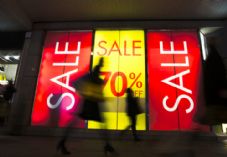UK DIY News
BRC: Christmas Boosts Retail Sales But Headwinds For 2023

The BRC has published retail sales data for December 2022.
Sales figures are not adjusted for inflation. Given that both the December SPI (BRC) and November CPI (ONS) show inflation running at historically record levels, the rise in sales masked a much larger drop in volumes once inflation is accounted for.
Covering the five weeks 27 November – 31 December 2022
- For 2022 overall, UK Total Retail sales increased by 3.1% from 2021. Food growth was 3.0% and Non-Food growth was 3.2% for the year.
- On a Total basis, sales increased by 6.9% in December, against an increase of 2.1% in December 2021. This is above both the 3-month average growth of 4.4% and 12-month average growth of 3.1%.
- UK retail sales increased 6.5% on a Like-for-like basis from December 2021, when they had increased by 0.6%. This was above the 3-month average growth of 4.1% and the 12-month average growth of 1.8%.
- Over the three months to December, Food sales increased 7.9% on a Total basis and 7.7% on a Like-for-like basis. This is above the 12-month Total average growth of 3.0%. For the month of December, Food was in growth year-on-year.
- Over the three-months to December, Non-Food sales increased 1.5% on a Total basis and 1.1% on a like-for-like basis. This is below the 12-month Total average growth of 3.2%. For the month of December, Non-Food was in growth year-on-year.
- Over the three months to December, In-Store sales of Non-Food items increased 5.3% on a Total basis and 4.5% on a Like-for-like basis since December 2021. This is below the 12-month growth of 25.6%.
- Online Non-Food sales decreased by 3.0% in December, against a decline of 13.9% in December 2021. This is above the 3-month average decline of 3.3% and the 12-month decline of 11.2%.
- The Non-Food Online penetration rate decreased to 42.3% in December from 44.3% at the same point a year earlier.
Helen Dickinson OBE, Chief Executive | British Retail Consortium
"After an exceptionally challenging year which saw inflation climb and consumer confidence plummet, the uptick in spending over Christmas gave many retailers cause for cheer. Many consumers braved the cold snap and the strikes to ensure friends and families got the gifts they wanted, with energy-saving products, warm clothing and boots all selling well. Nonetheless, despite the stronger sales, growth remained below inflation, making December the ninth consecutive month of falling volumes.
“Retail faces further headwinds in 2023. Cost pressures show little immediate signs of waning, and consumer spending will be further constrained by increasing living costs. Retailers are juggling big cost increases while trying to keep prices as low as possible for their customers. And, from April, they will be hit with an additional £7.5 billion energy bill should the Government’s Energy Support Scheme expire. We hope the Chancellor’s announcement this week will provide the necessary extension, or further prices rises will be inevitable.”
Paul Martin, UK Head of Retail | KPMG
“Whilst the numbers for sales growth in December look healthy, with sales values up by nearly 7% on last year, this is largely due to goods costing more and masks the fact that the volume of goods that people are buying is significantly down on this time last year.
“Consumers shunned big ticket technology purchases in December, opting for energy efficient household appliances and Christmas mainstays of clothes and beauty items. Food sales were also strong, growing nearly 8% year on year as families gathered at home to make the most of an unrestricted Christmas. Despite the bad weather, and with postal strikes ongoing, shoppers opted to head for the high street to browse for Christmas presents, with online sales growth continuing to slide across a number of categories.
“With Christmas behind us, retailers are facing a challenging few months as consumers manage rising interest rates and energy prices by reducing their non-essential spending, and industrial action across a number of sectors could also impact sales. The strong demand across certain categories that has protected some retailers will undoubtedly fall away so we can expect high street casualties as we head into the Spring. This will present opportunities and some organisations will benefit from the current situation through market-share growth and consolidation opportunities that will arise. The first half of the year will be tough for retail and a case of survival of the fittest, but we expect to see demand increase as 2023 progresses.”
Food & Drink sector performance | Susan Barratt, CEO | IGD
“December saw strong headline growth in food and drink sales, registering a notable acceleration over sales in November. With Christmas falling on a Sunday, the week ending Saturday 24 December delivered the biggest cash value ever recorded for a trading week in the sector. Despite this buoyancy, volumes in December were essentially flat, indicating that inflation continues to fuel growth. However, the flat volume number is an improvement on the rest of 2022, showing that Christmas still had the power to shift the direction of the market.
“The festive season provided some light relief with IGD’s Shopper Confidence Index registering its highest levels since July ’22. With no Covid restrictions for the first time since 2019, shoppers in London were the catalyst for boosting sentiment with confidence improving to -12 in the capital, compared to -22 in Nov’22. However, with the Office for Budget Responsibility predicting the greatest drop in living standards, shoppers will undoubtedly continue to adapt their shopping behaviour to help them save money in the new year.”
Source : BRC
Image : IR_Stone / iStockphoto.com (1355828207)
I find the news and articles they publish really useful and enjoy reading their views and commentary on the industry. It's the only source of quality, reliable information on our major customers and it's used regularly by myself and my team.











































